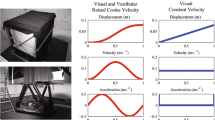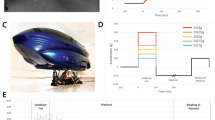Abstract
The brain is able to determine angular self-motion from visual, vestibular, and kinesthetic information. There is compelling evidence that both humans and non-human primates integrate visual and inertial (i.e., vestibular and kinesthetic) information in a statistically optimal fashion when discriminating heading direction. In the present study, we investigated whether the brain also integrates information about angular self-motion in a similar manner. Eight participants performed a 2IFC task in which they discriminated yaw-rotations (2-s sinusoidal acceleration) on peak velocity. Just-noticeable differences (JNDs) were determined as a measure of precision in unimodal inertial-only and visual-only trials, as well as in bimodal visual–inertial trials. The visual stimulus was a moving stripe pattern, synchronized with the inertial motion. Peak velocity of comparison stimuli was varied relative to the standard stimulus. Individual analyses showed that data of three participants showed an increase in bimodal precision, consistent with the optimal integration model; while data from the other participants did not conform to maximum-likelihood integration schemes. We suggest that either the sensory cues were not perceived as congruent, that integration might be achieved with fixed weights, or that estimates of visual precision obtained from non-moving observers do not accurately reflect visual precision during self-motion.



Similar content being viewed by others
References
Bakker NH, Werkhoven PJ, Passenier PO (1999) The effects of proprioceptive and visual feedback on geographical orientation in virtual environments. Presence 8(1):36–53
Barnett-Cowan M, Harris LR (2011) Temporal processing of active and passive head-movement. Exp Brain Res 214:27–35
Barnett-Cowan M, Raeder SM, Bülthoff HH (2012) Persistent perceptual delay for head movement onset relative to auditory stimuli of different durations and rise times. Exp Brain Res 220:41–50
Benson AJ, Hutt ECB, Brown SF (1989) Thresholds for the perception of whole body angular movement about a vertical axis. Aviat Space Environ Med 60(3):205–213
Butler JS, Smith ST, Campos JL, Bülthoff HH (2010) Bayesian integration of visual and vestibular signals for heading. J Vis 10(11):1–13
Butler JS, Campos JL, Bülthoff HH, Smith ST (2011) The role of stereo vision in visual-vestibular integration. See Perceiving 24:453–470
De Vrijer M (2010) Multisensory integration in spatial orientation. Dissertation, Radboud Universiteit Nijmegen, The Netherlands
De Winkel KN, Weesie J, Werkhoven PJ, Groen EL (2010) Integration of visual and inertial cues in perceived heading of self-motion. J Vis 10:1
Di Luca M (2010) New method to measure end-to-end delay of virtual reality. Presence 19(6):569–584
Dichgans J, Wist E, Diener HC, Brandt Th (1975) The Aubert Fleischl phenomenon: a temporal frequency effect on perceived velocity in afferent motion perception. Exp Brain Res 23:529–533
Draper NR, Smith H (1966) Applied regression analysis. Wiley, New York
Ernst MO, Banks MS (2002) Humans integrate visual and haptic information in a statistically optimal fashion. Nature 415:429–433
Ernst MO, Bülthoff HH (2004) Merging the senses into a robust percept. Trends Cogn Sci 8:162–169
Fernandez C, Goldberg J (1971) Physiology of peripheral neurons innervating semicircular canals of squirrel monkey. II. Response to sinusoidal stimulation and dynamics of peripheral vestibular system. J Neurophysiol 34(4):661–675
Fetsch CR, Turner AH, DeAngelis GC, Angelaki DE (2009) Dynamic reweighting of visual and vestibular cues during self-motion perception. J Neurosci 29(49):15601–15612
Gu Y, Angelaki DE, DeAngelis GC (2008) Neural correlates of multisensory cue integration in macaque MSTd. Nat Neurosci 11(10):1201–1210
Howard IP, Heckmann T (1989) Circular vection as a function of the relative sizes, distances, and positions of two competing visual displays. Perception 18(5):657–665
Jürgens R, Becker W (2006) Perception of angular displacement without landmarks: evidence for Bayesian fusion of vestibular, optokinetic, podokinesthetic and cognitive information. Exp Brain Res 174:528–543
Jürgens R, Becker W (2011) Human spatial orientation in non-stationary environments: relation between self-turning perception an detection of surround motion. Exp Brain Res 215:327–344
Kontsevich LL, Tyler CW (1999) Bayesian adaptive estimation of psychometric slope and threshold. Vis Res 39:2729–2737
Körding K (2007) Decision theory: what “should” the nervous system do? Science 318:606–610
Lambrey S, Berthoz A (2003) Combination of conflicting visual and non-visual information for estimating actively performed body turns in virtual reality. Int J Psychophysiol 50:101–115
Macmillan NA, Creelman CD (2005) Detection theory: a user’s guide. Lawrence Erlbaum Associates, Mahwah
MacNeilage PR, Banks MS, Berger DR, Bülthoff HH (2007) A Bayesian model of the disambiguation of gravitoinertial force by visual cues. Exp Brain Res 179(2):263–290
Merfeld DM (2011) Signal detection theory and vestibular thresholds: I. Basic theory and practical considerations. Exp Brain Res 210:389–405
Miller I, Miller M (2004) John E. Freund's mathematical statistics with applications, 7th edn. Pearson Education, USA
Pavard B, Berthoz A (1977) Linear acceleration modifies perceived velocity of a moving visual scene. Perception 6(5):529–540
Polit D (1996) Data analysis and statistics for nursing research. Appleton & Lange, Stamford
Probst T, Brandt T, Degner D (1986) Object-motion detection affected by concurrent self-motion perception. Behav Brain Res 22:1–11
Rock I, Victor J (1964) Vision and touch: an experimentally created conflict between the two senses. Science 143:594–596
Roy JE, Cullen KE (2004) Dissociating self-generated from passively applied head motion: neural mechanisms in the vestibular nuclei. J Neurosci 24(9):2102–2111
Shirai N, Ichihara S (2012) Reduction in sensitivity to radial optic-flow congruent with ego-motion. Vis Res 62:201–208
Tanner T (2008) Generalized adaptive procedure for psychometric measurement. Perception 37:93 ECVP abstract supplement p 93
Thompson PG (1976) Velocity aftereffects and the perception of movement. PhD Thesis, University of Cambridge, Cambridge, UK
Wertheim AH, Reymond G (2007) Neural noise distorts perceived motion: the special case of the freezing illusion and the Pavard and Berthoz effect. Exp Brain Res 180:569–576
Wertheim AH, Mesland BS, Bles W (2001) Cognitive suppression of tilt sensations during linear horizontal self-motion in the dark. Perception 30(6):733–741
Acknowledgments
This research was supported by Grant Number ALWGO-MG/08-04 of the Netherlands Institute for Space Research (SRON) and the European research project SUPRA (Contract FP7-233543, www.supra.aero). F.S. and M.B.C. were supported by Max Planck Society stipends. H.H.B was supported by the WCU (World Class University) program through the National Research Foundation of Korea funded by the Ministry of Education, Science and Technology (R31–10008). The authors wish to thank J. Weesie and R. van de Pijpekamp for scientific discussion and technical support.
Author information
Authors and Affiliations
Corresponding author
Additional information
K. N. de Winkel and F. Soyka have contributed equally to the work.
Rights and permissions
About this article
Cite this article
de Winkel, K.N., Soyka, F., Barnett-Cowan, M. et al. Integration of visual and inertial cues in the perception of angular self-motion. Exp Brain Res 231, 209–218 (2013). https://doi.org/10.1007/s00221-013-3683-1
Received:
Accepted:
Published:
Issue Date:
DOI: https://doi.org/10.1007/s00221-013-3683-1




